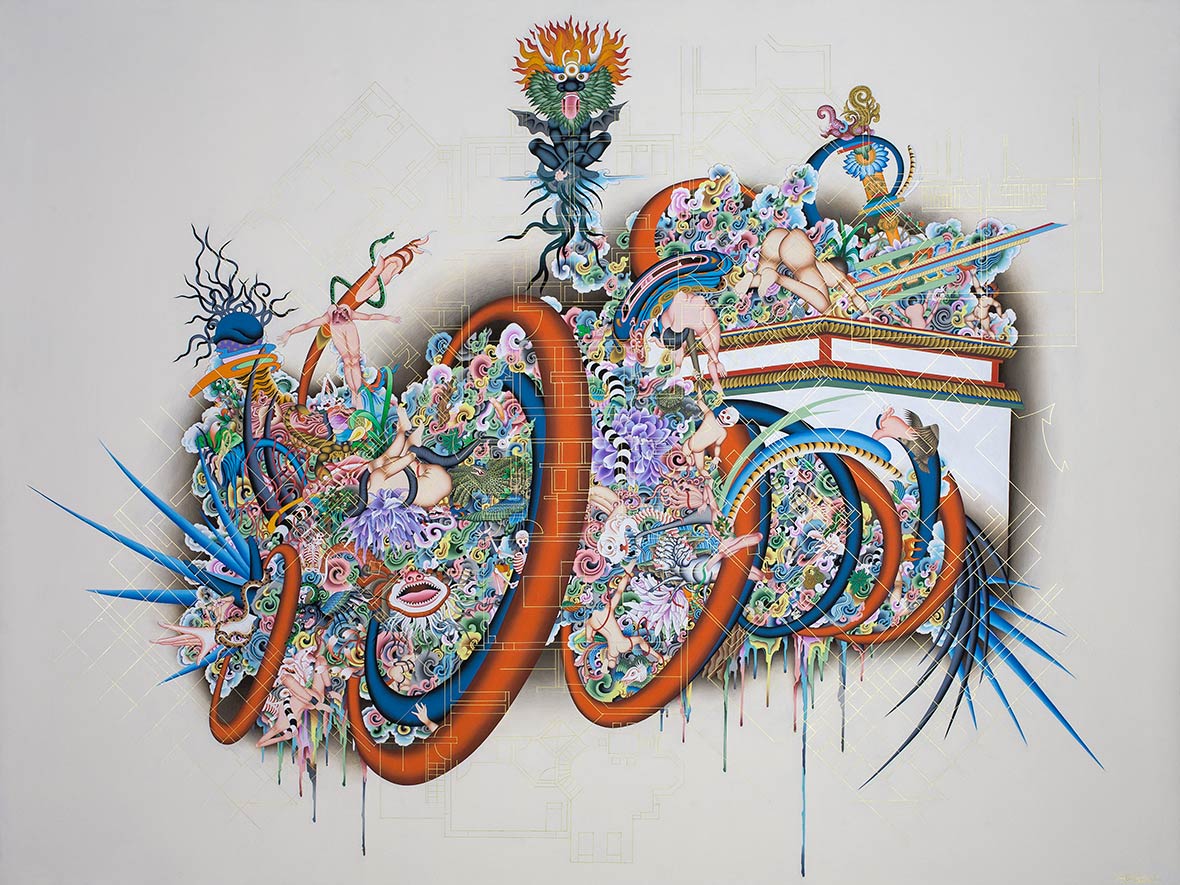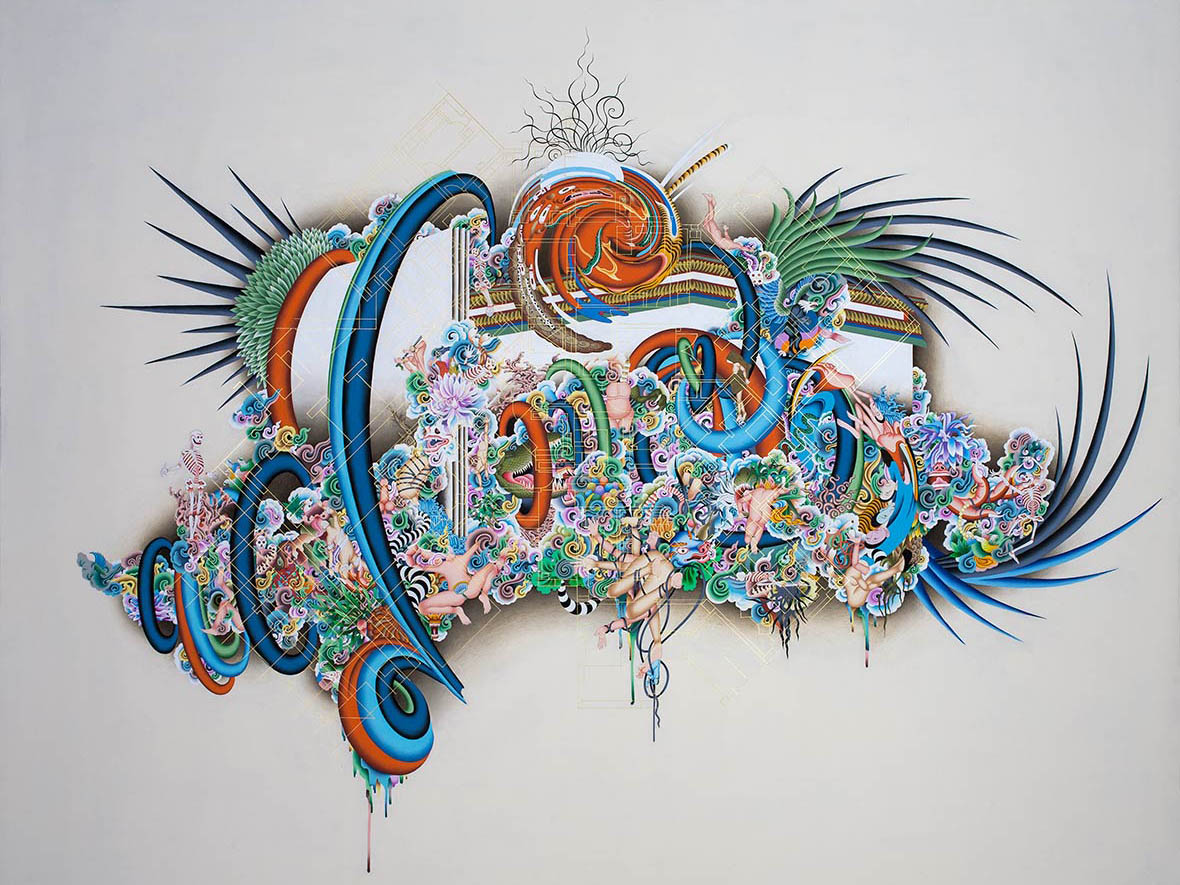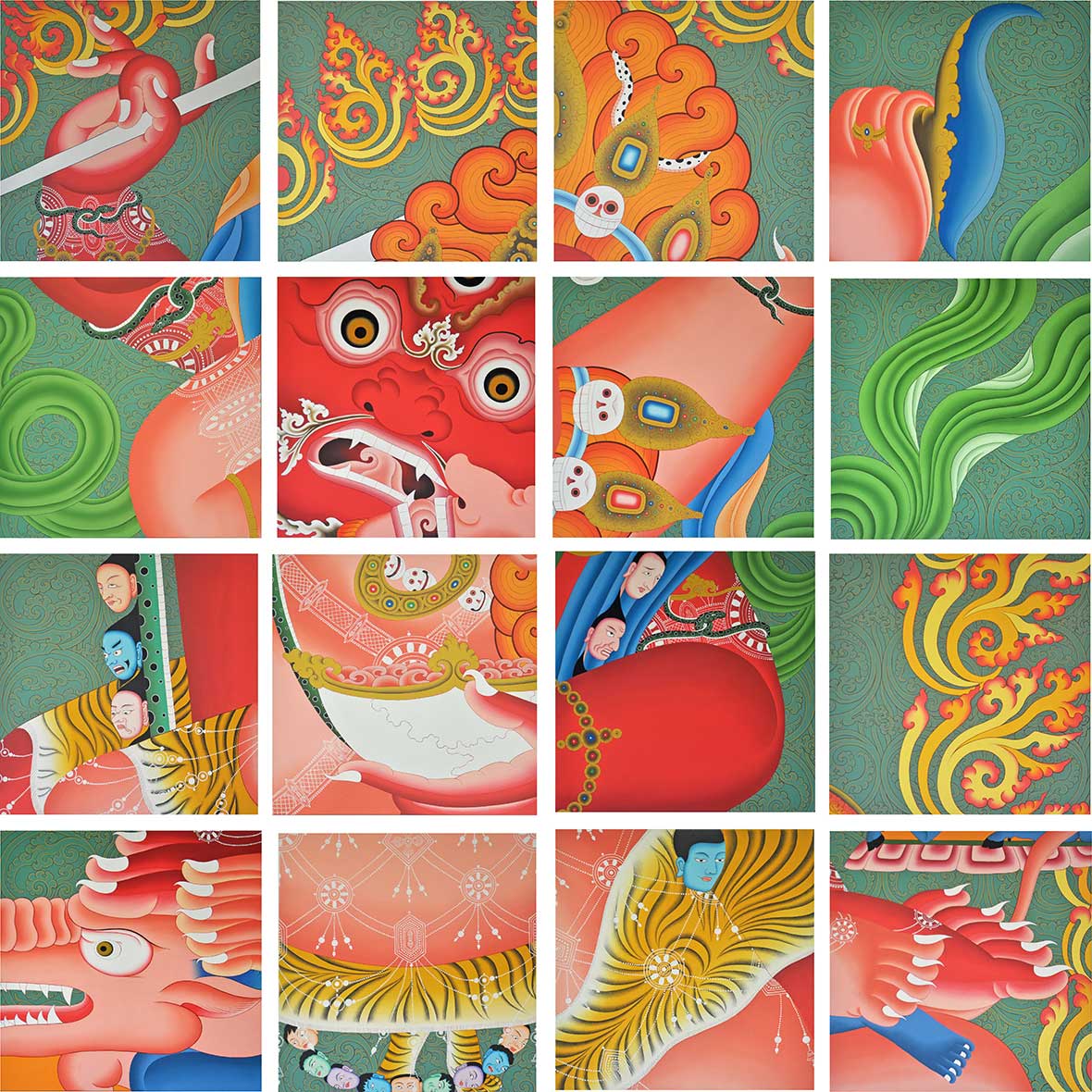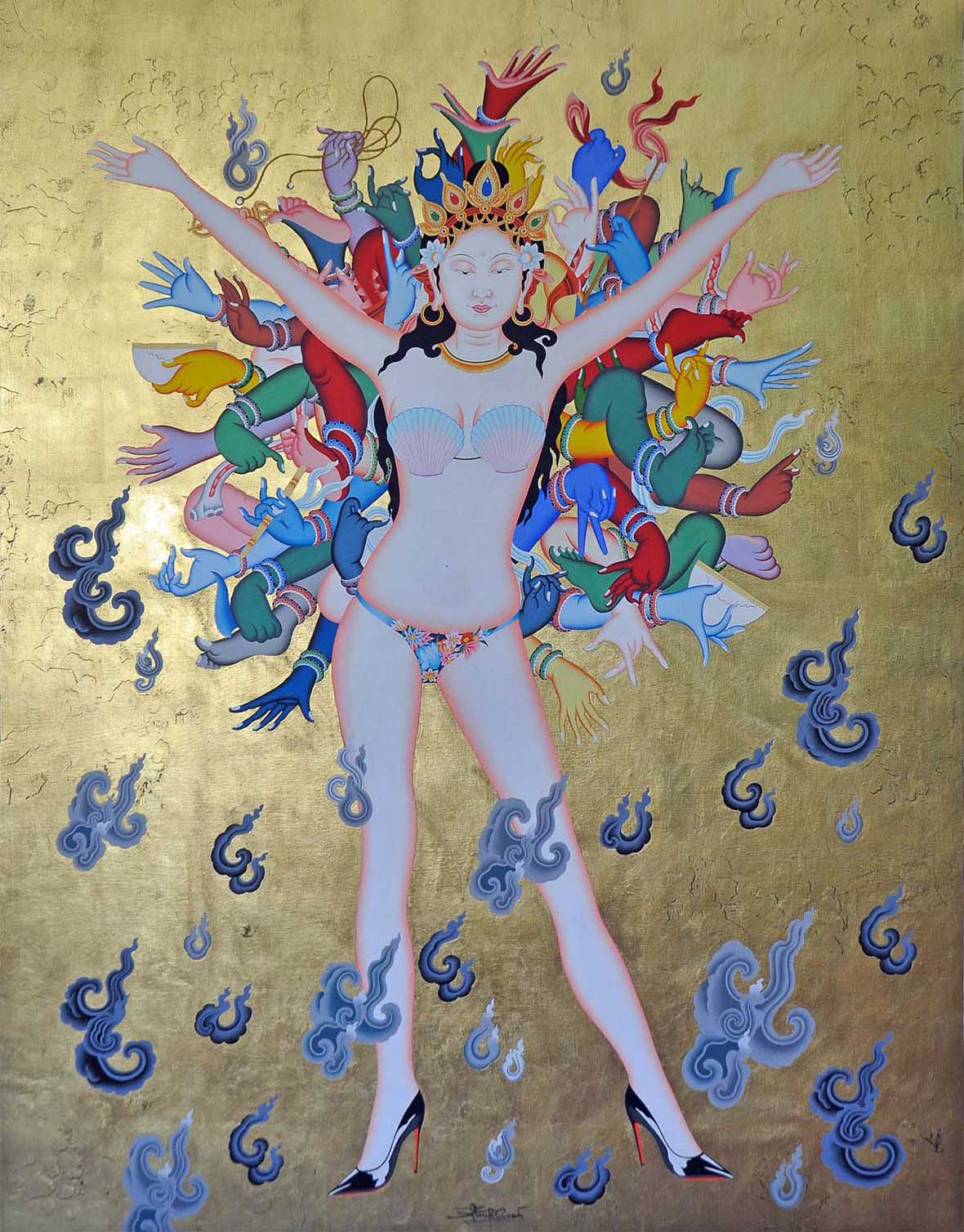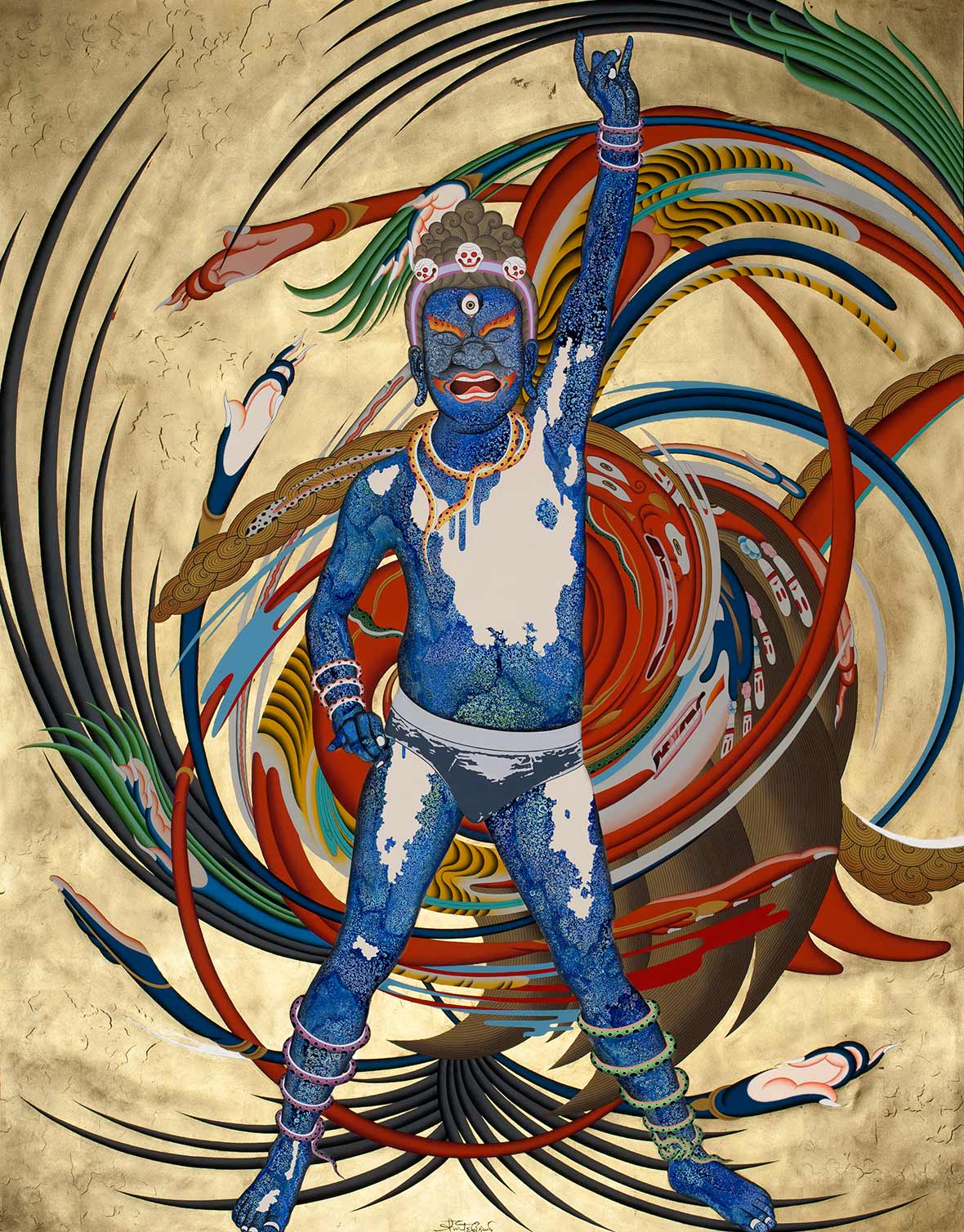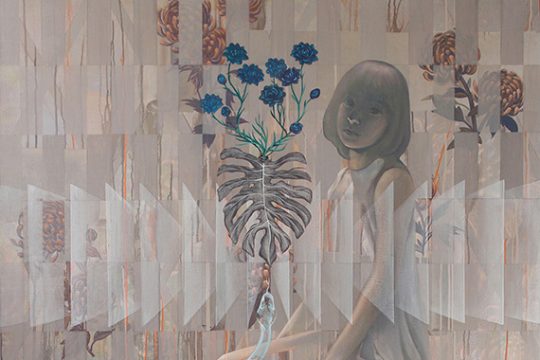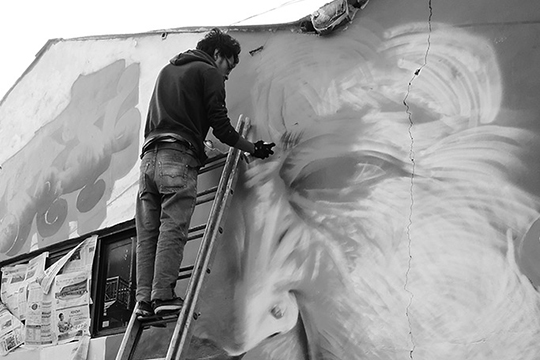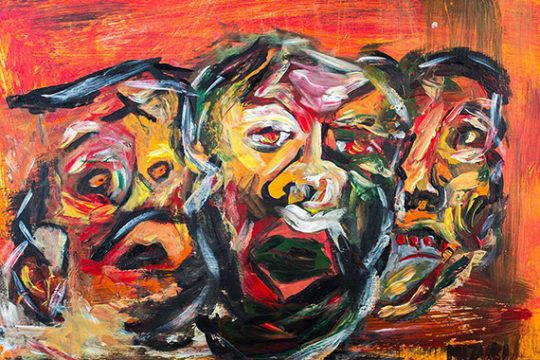
Gold leaf, acrylic and ink on canvas
(50 x 90 in)
Tsherin Sherpa is a Tibetan artist who explores contemporary themes through his neo-traditional approach to Tibetan thangka painting. Born in Kathmandu, Nepal, he began studying thangka painting as a child under the tutelage of his father, Master Urgen Dorje, a renowned Tibetan thangka artist. In 1998, Sherpa moved to California, where he initially worked at a Buddhist center as a thangka artist and teacher. During this period, his introduction to the world of fine art led him to study art theory and art history, and to explore new works and mediums that are outside of traditional boundaries. Neocha spoke to Sherpa about his thoughts on art, culture, and Tibetan traditions in the modern world.
藏族艺术家Tsherin Sherpa通过“新传统“(neo-traditional)风格创作藏族唐卡绘画,探索各种当代艺术主题。Sherpa 出生于尼泊尔加德满都,他的父亲是著名的藏族唐卡艺术大师Urgen Dorje,Sherpa从小就跟随父亲学习唐卡绘画。1998年,Sherpa 来到美国加州。最初,他在当地一个佛教中心担任唐卡艺术家和教师。在此期间,他开始接触艺术,这促使他进一步去学习艺术理论和艺术史,并在传统界限之外探索新的作品和创作媒体。最近,Neocha与 Sherpa对话,了解他对艺术、文化和藏族传统在现代世界的一些想法。
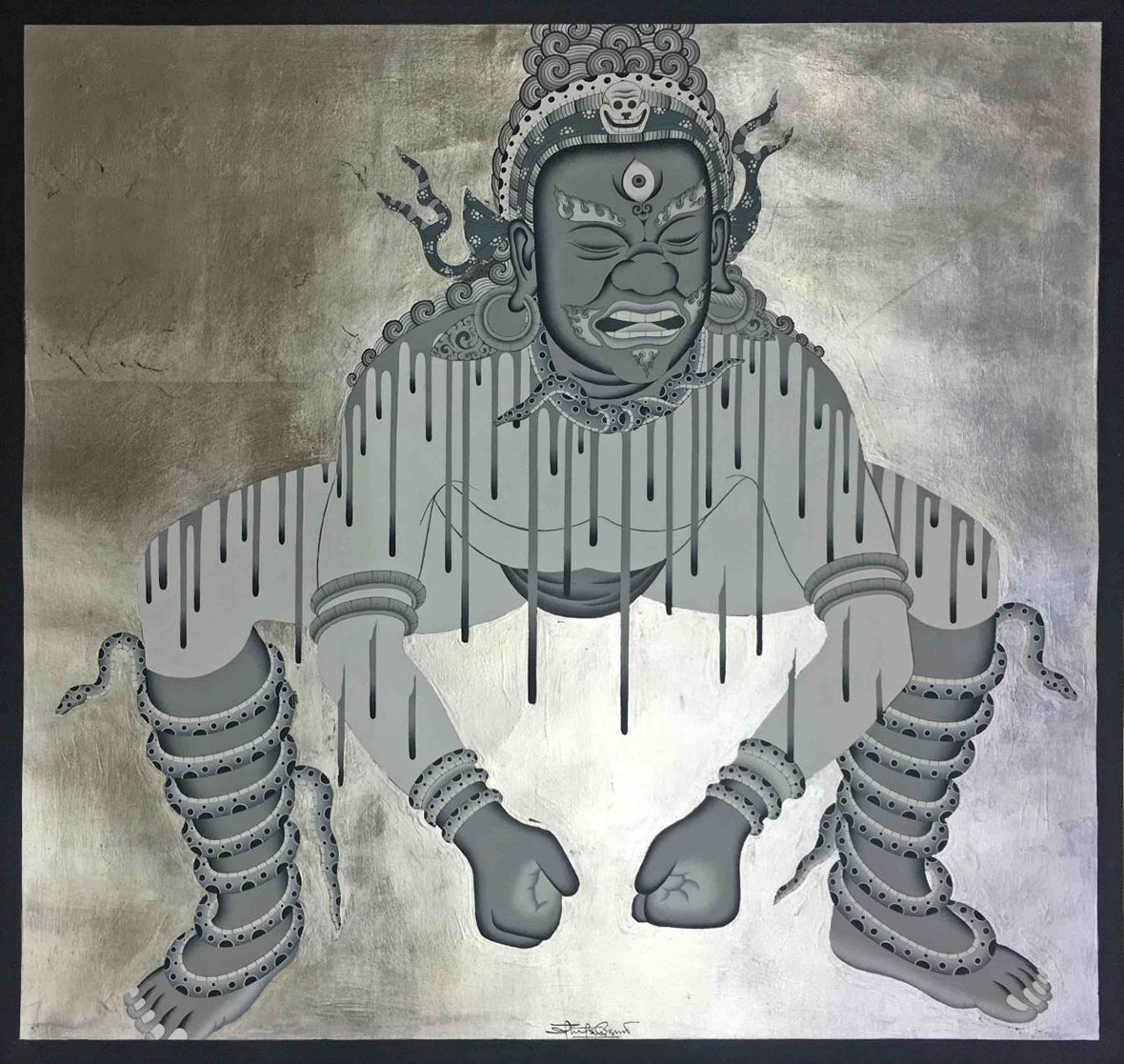
Platinum leaf, acrylic and ink on cotton
18¾ x 20 in
Neocha: How did you get started as an artist?
Tsherin Sherpa: At around the age of 13, my father decided to train me in the traditional art of thangka painting after seeing my interest in drawing. The formal training lasted for about five years. Training at such a young age was very tedious in the beginning. My first lesson was on drawing the head of the Buddha with a traditional grid measurement system, which I drew every day for almost three months. It was all about mastering the skill through repetition. After that, I learned how to prepare the mineral pigment paint, paint application, brush making, canvas preparation, and fine outlining with ink and gold. After a few years, I also studied Buddhist philosophy to understand the symbolism of Buddhist imagery.
Neocha: 你是怎样成为一名艺术家的?
Tsherin Sherpa: 在我大概13岁的时候,我的父亲发现了我对绘画的兴趣之后,决定让我学习唐卡绘画这种传统艺术。正式的学习持续了大约五年。在刚开始的时候,我年纪还很小,所以学习的时候会觉得很沉闷乏味。 我的第一堂课是在一个传统网格上画佛像的头部,连续三个月的时间里我每天都要画同样的佛像头部。通过反复的练习来掌握技巧。在那之后,我学会了如何制作绘画用的矿物颜料,如何上色,如何制作画笔和准备画布,以及如何用墨水甚至是黄金进行精美勾线。几年后,我还学习了佛教哲学,来进一步理解佛教意象中的象征意义。
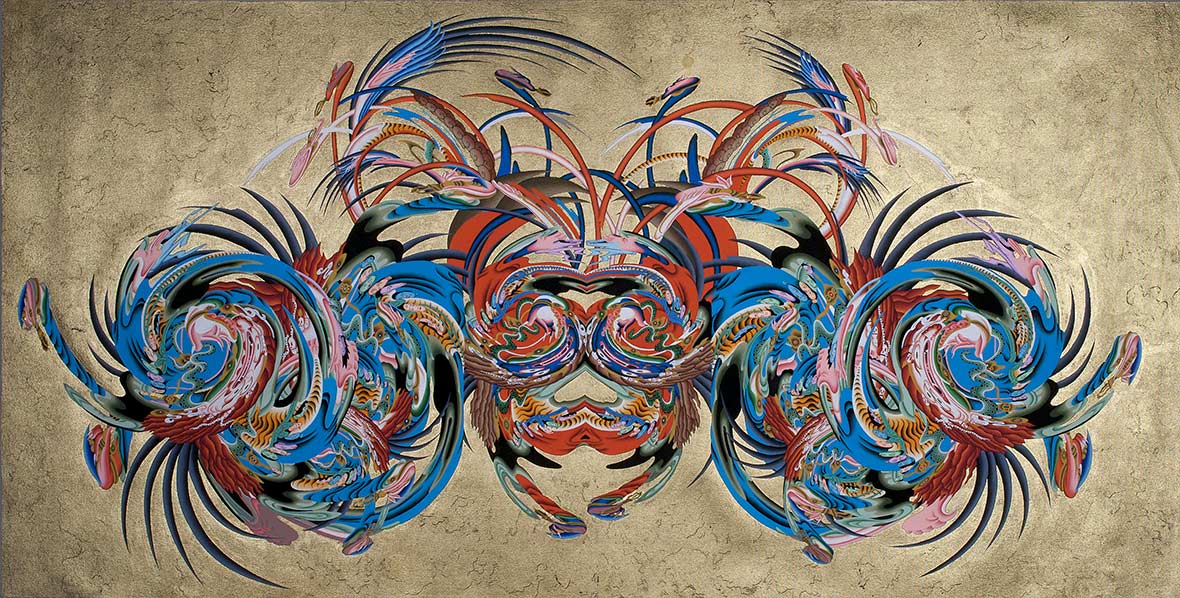
Gold leaf, acrylic and ink on canvas
36 x 71 in
Neocha: Can you tell us a bit about your creative process and technique? Where do you draw inspiration from?
Tsherin Sherpa: My recent works are very much inspired and informed by my own situation, as well as everything I experience around me. For example, the recent solo show I had in Hong Kong at Rossi & Rossi Gallery, titled Beautiful Decay, was inspired by the 2015 earthquake in Nepal. As for my technique, I blend traditional thangka painting techniques with several other techniques using various materials, which I experiment with on a regular basis in my studio. I am actually inspired and influenced by many artists both from the past and present: Duchamp, Warhol, and Murakami, to name a few.
Neocha: 你能跟我们分享一下你的创作过程和技巧吗?你创作的灵感从何而来?
Tsherin Sherpa: 我最近的作品的灵感大多来自于我生活的环境,以及我每天经历到的事情。例如,最近我在香港Rossi & Rossi Gallery举办的名为《Beautiful Decay》的个展,这些作品的灵感就来自于尼泊尔2015年的大地震。至于我的创作技巧,我会将传统唐卡绘画技法结合其他技巧和材料一起创作,我经常在我的工作室里进行不同的试验。实际上,我会从过去和现在的很多艺术家身上受到启发和影响,譬如Duchamp,Warhol和Murakami等等。
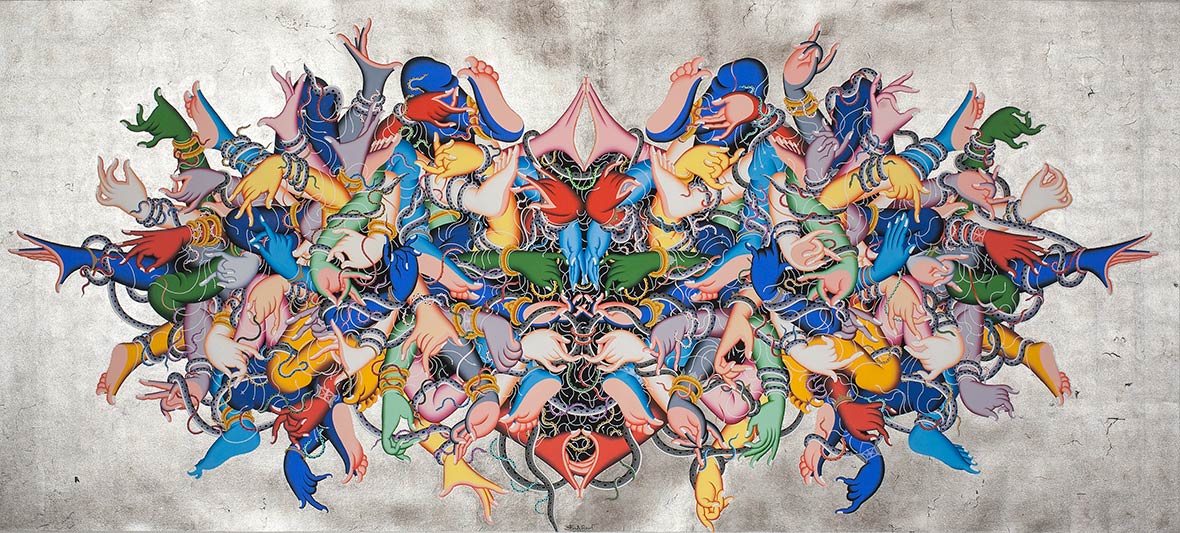
Platinum leaf, acrylic and ink on canvas
46 x 102 in
Neocha: One of the main themes in your work is the profane versus the sacred. Can you tell us more about that?
Tsherin Sherpa: It’s fascinating to see how icons and imagery connote different meanings to different people. I am interested in exploring and understanding the functionality of these images from one culture, and their perception among people from various backgrounds who may or may not be familiar with that culture. It’s interesting to see how people, who are familiar with the culture, interact and confront the work, in comparison to people who are experiencing it for the first time. For example, works such as Luxation 1 and Luxation 2 consist of sixteen fragments of a traditional thangka. Those who are familiar with the image can immediately recognize the iconography, or even reconnect the fragments in their mind. But someone who may not be familiar with the iconography or the culture may find it to be an abstract design.
Neocha: 你的作品中的其中一个重要主题是世俗与神圣。你能跟我们介绍一下这个主题吗?
Tsherin Sherpa: 不同的人对各种雕像和意象的含义会有不同的理解,这一点是很有趣的。我很喜欢去探索了解一个图象在某种特定文化中的功能,以及来自不同背景的人们对这些图象的认知,他们可能熟悉也可能不了解这图象背后的文化。将一些熟悉这种文化的人看到我的作品时的反应,与那些对这种文化陌生的人们第一次看到这些图象时的体验作对比,这是很有趣的。例如,《Luxation 1》和《Luxation 2》这两个作品中包含了传统唐卡艺术的十六块碎片,熟悉这些图象的人马上就能看出来,甚至能在他们脑中重新拼贴这些碎片,但对不太熟悉这图象或文化的人来说,他们可能会觉得这是一种抽象的设计。
Neocha: Another one of your main themes is the preservation of culture. How do you maintain Tibetan tradition while being an artist in the modern world?
Tsherin Sherpa: Because of the training I’ve received from my childhood until now, and having grown up surrounded by Tibetan culture, the traditional iconography has remained a part of my vocabulary, through which I use to explore contemporary concerns. There isn’t so much emphasis on the preservation of Tibetan traditions in my work. To me, the Tibetan identity, iconography, and tradition are simply the starting points of the conversation through which everything else is explored.
Neocha: 你的作品的另一个重要主题是文化保护。作为一位当代艺术家,你要如何延续藏族传统文化?
Tsherin Sherpa: 由于我从小就一直在学习传统藏族文化艺术,也一直在藏族文化的氛围中长大,藏族文化的传统意象已经深深铭刻在我的脑海深处,是我用来探索当代实事问题的创作素材。在我的作品中,并没有特别强调对藏族传统文化的保护。对我来说,藏族身份、藏族意象和传统文化只是我探索其它事物的起点。
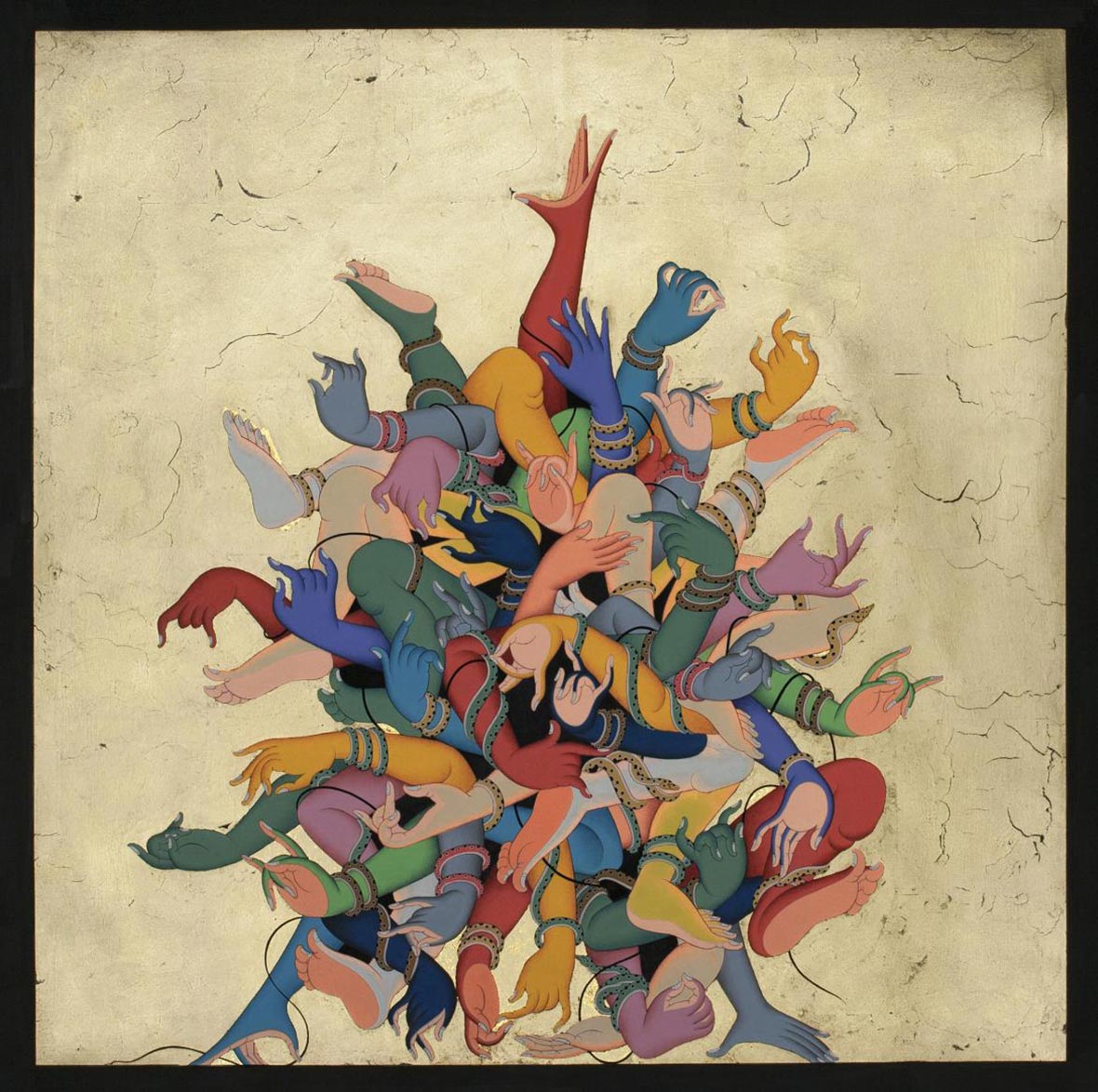
Gold leaf, acrylic and ink on paper
22¼ x 22¼ in
Neocha: Your recent work, Wish Fulfilling Tree, was in response to the Nepal earthquake of 2015. Can you tell us more about that project?
Tsherin Sherpa: On April 2015, a catastrophic earthquake generated a shockwave that coursed through the people and structures of Nepal. Being away in America, images and stories of the destruction and aftermath arrived through secondhand sources. Not until August of that year did I personally witness the damage to familiar locations and neighborhoods from my childhood. Seeing my home uprooted sparked the initial desire to bear witness and rebuild.
For this project, I chose the traditionally inspired structure of the mandala, for within its structure, it holds the connotations of home, wholeness, and harmony. As I traveled around, I listened to neighbors’ stories about what they had gone through and what they still needed in order to rebuild. Many people were living in temporary structures since their homes were uninhabitable. People continued waiting for the arrival of funding to aid them. With these experiences arose a natural desire to work with the Nepalese people as an act of healing. I photographed survivors as a part of my documentation. I collected broken household objects that were damaged during the earthquake. These objects may seem random, but they hold special memories tied to homes and families. By gathering them all together in a new arrangement, they begin re-contextualization into something that is stronger than the individual fragments. A further shared commonality was acquired by asking seven hundred survivors to sign five rupee bank notes as a wish or prayer. I collaborated with local craftsmen to make the copper structure of the mandala that now contains these gathered objects as well as my spirit figure holding its hands up in a peace symbol. It’s hoped that the symbolic communal wish will reverberate back out into the community for the healing and rebuilding process of Nepal.
Neocha: 你最近的作品《Wish Fulfilling Tree》是为2015 年的尼泊尔地震事件而创作的。你能跟我们介绍一下这个项目吗?
Tsherin Sherpa: 2015 年 4 月,一次灾难性的地震对尼泊尔的居民和建筑都造成了巨大的冲击。当时我身在美国,只能通过二手资源的图片和报道来了解那次灾难和善后工作。直到那年的 8 月,我才得以亲自目睹这场地震对尼泊尔造成的伤害,那是一个我曾经十分熟悉的社区,我度过童年的地方。看到我的家被连根拔起,激发了我要记录这场灾难和重建的愿望。
对于这个项目,我选择了以传统文化为灵感的曼荼罗结构,因为它代表了家,和谐和完整。我四处游走,聆听邻居们的经历和他们重建家园的需求。很多人都住在临时搭建的“家”里,因为他们原本的家已经无法居住,人们还在等待援助资金的到来。这些体验很自然地激发了我与尼泊尔人们一起努力的渴望。对我来说,这也是一种愈伤的行为。我拍摄了当地的幸存者,作为我的纪录片的一部分。我还收集了当地居民家中在地震中破碎了的物品。虽然只是很普通的物件,但都代表了这些家庭的特别回忆。我将它们收集起来放在一起,形成新的组合,来重新讲述那些故事。相比单独个体来说,新的组合产生更强有力的冲击力。我还邀请了七百名幸存者在五张尼泊尔纸币上签名,作为一种愿望或祷告,进一步加强这种共性凝聚的力量。我和当地的工匠合作,打造出铜制的曼荼罗结构,在上面加入这些收集回来的小物件,以及我设计的做和平手势的人像。我希望在尼泊尔重建的漫漫长路中,这件作品所承载的美好愿望能留存于人们的心里。
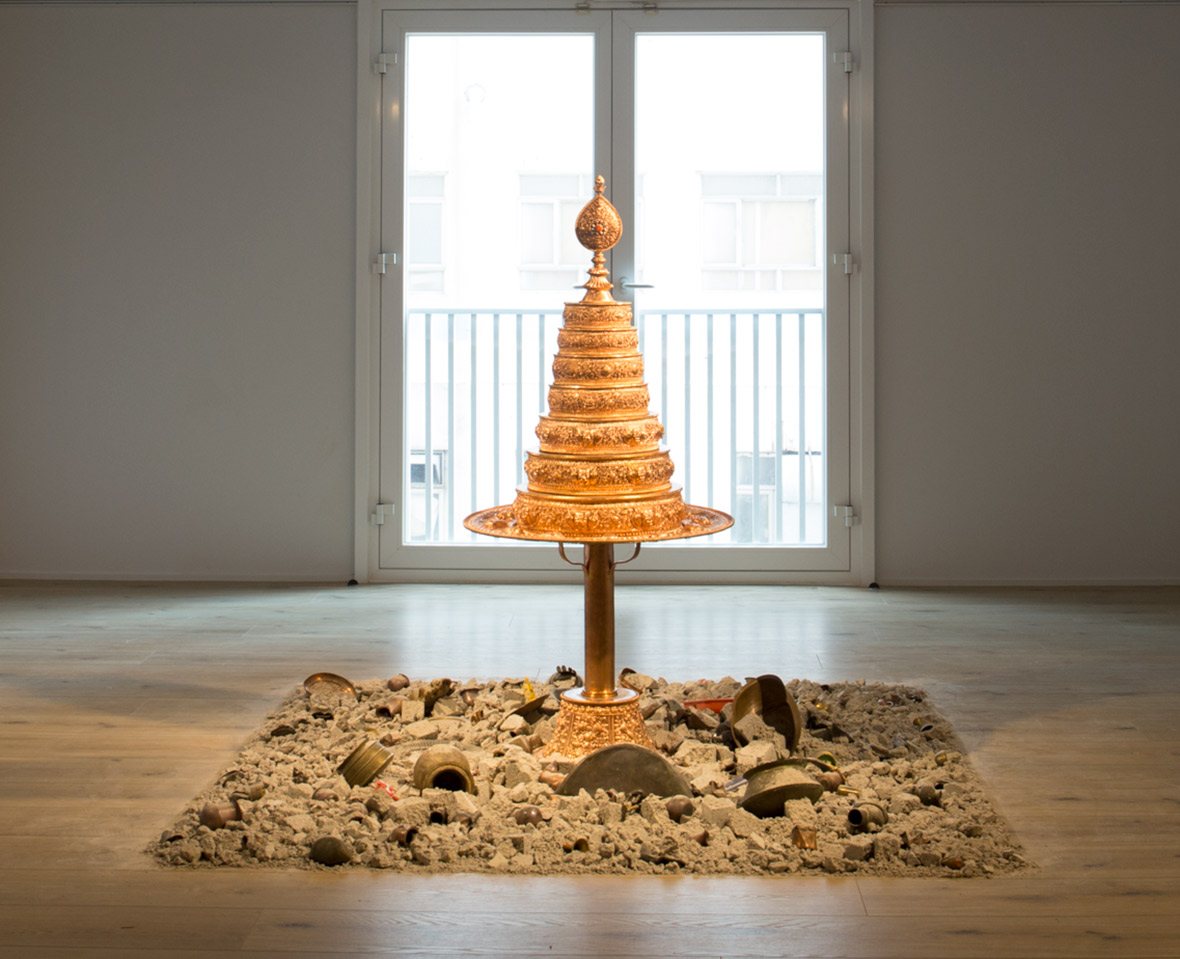
Cast-bronze mandala, found objects and signed Nepalese rupee notes
Dimensions variable
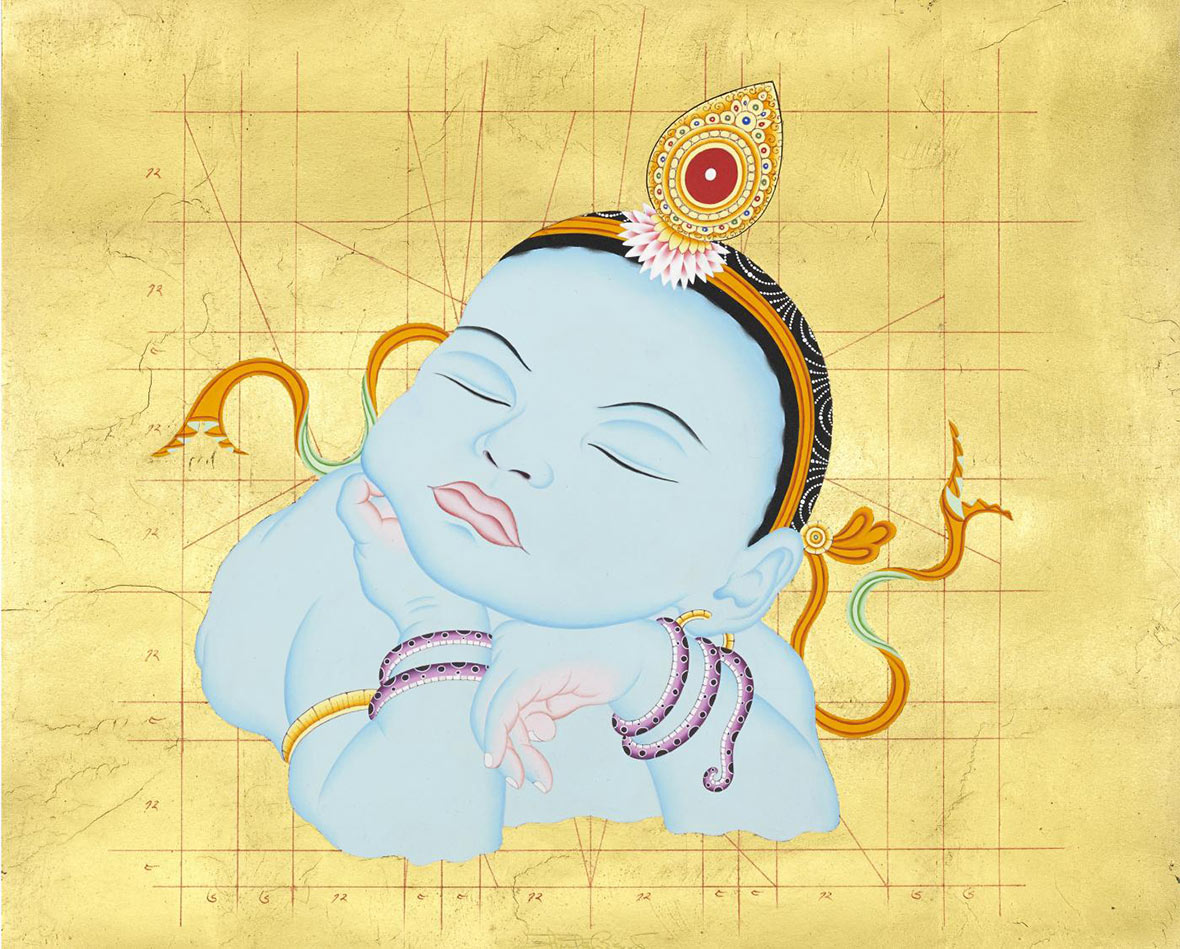
Gold leaf, acrylic and ink on paper
13 x 16 in
Neocha: Any upcoming plans you would like to share with our readers?
Tsherin Sherpa: I’m participating in a couple of current and upcoming shows, including Between Us: Relationship and Identity in Tibetan Contemporary Art at the Frank Museum of Arts at Otterbein University in Ohio, USA, and the Kathmandu Triennale 2017: The City, My Studio in Kathmandu, Nepal.
Neocha: 你有任何即将推出的项目想要与我们的读者分享的吗?
Tsherin Sherpa: 我正在筹备一些展览,有正在进行中的也有即将推出的展览,包括在美国俄亥俄州奥特拜因学院弗兰克艺术博物馆(Frank Museum of Arts)举办的《我们之间︰藏族当代艺术中的关系和身份》(Between Us:Relationship and Identity in Tibetan Contemporary Art)和和在尼泊尔加德满都举办的《2017加德满都三年展︰这座城市,我的工作室》(Kathmandu Triennale 2017:The City, My Studio)。
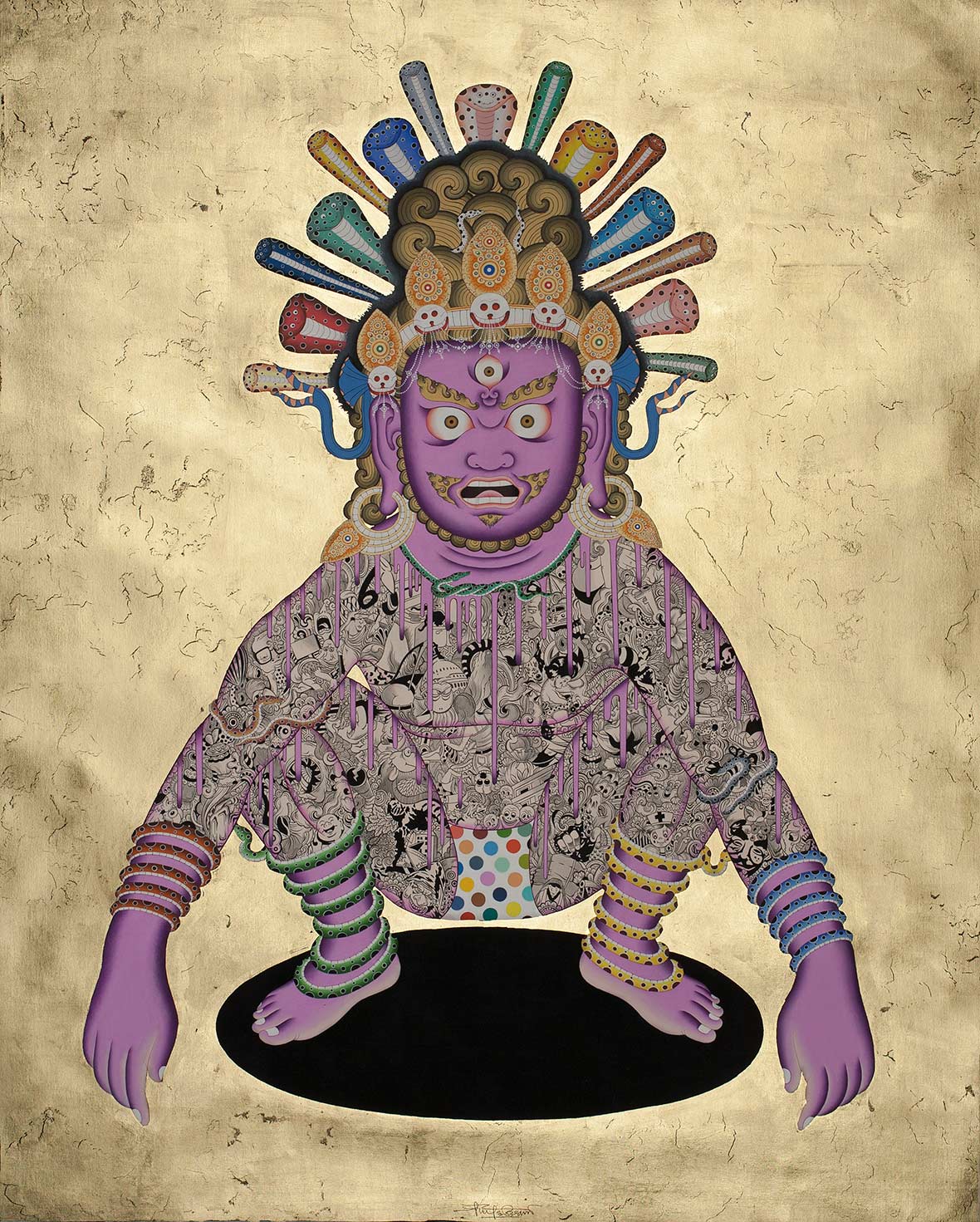
Gold leaf, acrylic and ink on cotton
31¾ x 26¼ in
Website: tsherinsherpa.com
Contributor: George Zhi Zhao
Images Courtesy of Tsherin Sherpa and Rossi & Rossi Gallery

